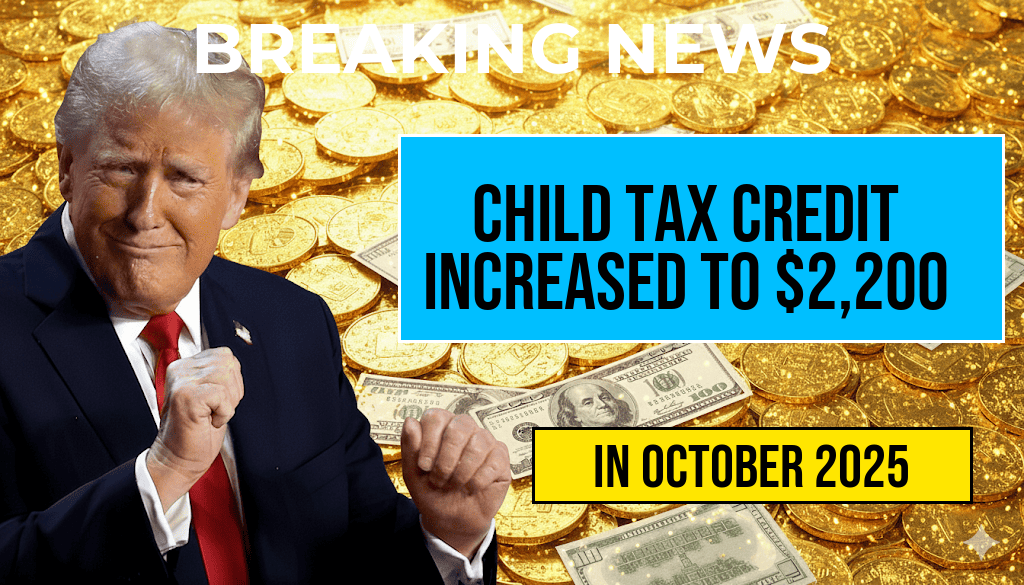The Child Tax Credit has experienced a significant increase, raising the maximum benefit to $2,200 per qualifying child, a move designed to provide greater economic support for millions of families nationwide. This adjustment, part of recent federal policy changes, aims to ease financial pressures faced by parents amid ongoing economic challenges. The enhancement is expected to impact over 35 million families, offering targeted relief that helps cover essential expenses such as childcare, education, and basic living costs. The new credit amount reflects a broader effort to strengthen the social safety net and address disparities in family assistance programs, aligning with ongoing discussions about economic equity and child welfare across the United States.
Background on the Child Tax Credit
The Child Tax Credit (CTC) has been a crucial component of U.S. tax policy, providing families with direct financial assistance to offset the costs of raising children. Originally established in 1997, the credit has undergone multiple expansions and modifications, with the most recent significant change occurring during the COVID-19 pandemic when it was temporarily increased and expanded under the American Rescue Plan Act of 2021. These adjustments aimed to reduce child poverty and support economic stability during uncertain times.
Details of the Recent Increase
The latest policy update raises the maximum Child Tax Credit from $2,000 to $2,200 per eligible child under age 17. This increase applies to families filing as individuals earning up to $75,000 annually, with phased reductions for higher earners. For married couples filing jointly, the income threshold rises to $150,000. The enhanced credit is designed to be fully refundable, ensuring that low-income families receive the full benefit regardless of their tax liability.
Key features of the new credit include:
- Maximum benefit: $2,200 per child
- Eligibility criteria: Children under age 17, with income limits based on filing status
- Refundability: Fully refundable, ensuring benefit access for low-income families
- Payment schedule: Monthly advance payments are available, similar to pandemic-era measures
Impacts on Families and the Economy
The increased Child Tax Credit aims to reduce child poverty significantly, which has long been a concern among policymakers and social advocates. According to the Wikipedia entry on child poverty in the U.S., nearly 1 in 6 children live below the federal poverty line. Experts suggest that boosting the credit can lift millions of children out of poverty and improve health, educational outcomes, and future economic prospects.
Economists project that the enhanced credit will inject billions of dollars into local economies, with families more able to afford essentials. The increased support also aims to reduce reliance on other social safety net programs by providing more direct financial aid to families in need.
Implementation and Public Response
Administration and Distribution
The Internal Revenue Service (IRS) is responsible for implementing the increased credit, utilizing existing infrastructure from previous child benefit programs. Families can expect to receive monthly payments, which began rolling out earlier this year, with the full credit accessible through filing annual tax returns or through advance payments if they opted in.
Public Reception
Reactions to the increase have been largely positive from family advocacy groups and labor organizations, emphasizing its potential to alleviate economic hardship. However, some fiscal conservatives have raised concerns about the long-term financial sustainability of expanding child benefits, emphasizing the need for balanced federal budgeting.
Additional Support Measures and Future Outlook
The increase in the Child Tax Credit complements other federal initiatives aimed at supporting families, such as expanded Child Care Assistance and increased Earned Income Tax Credit thresholds. As discussions about economic policy continue, lawmakers are debating the possibility of making these enhancements permanent, which could fundamentally reshape the landscape of family assistance programs in the U.S.
| Year | Maximum Credit | Income Limits (Single / Married Filing Jointly) |
|---|---|---|
| 2022 | $2,000 | $75,000 / $150,000 |
| 2023 (Current) | $2,200 | $75,000 / $150,000 |
For families seeking additional information or assistance in claiming the Child Tax Credit, resources are available through the IRS official website. Continued policy developments suggest that the current enhancements could serve as a foundation for longer-term reforms aimed at reducing child poverty and promoting economic security for low- and middle-income households.
Frequently Asked Questions
What is the new amount for the Child Tax Credit?
The Child Tax Credit has been increased to $2,200 per qualifying child, providing greater financial support to families.
Which families are eligible for the increased Child Tax Credit?
Eligible families with children under 17 who meet certain income criteria can now receive the increased Child Tax Credit amount, helping more families access financial assistance.
How does the increased Child Tax Credit benefit families?
The increase in the Child Tax Credit amount offers additional financial support to families, helping cover expenses related to raising children and improving their overall financial stability.
When will families start receiving the increased Child Tax Credit?
Families can expect to start receiving the increased Child Tax Credit through monthly payments or at tax time, depending on their filing status and eligibility criteria.
Are there any changes to how the Child Tax Credit is claimed on taxes?
Yes, families should review the latest IRS guidelines to understand any new requirements or adjustments needed to claim the increased Child Tax Credit on their tax returns.






